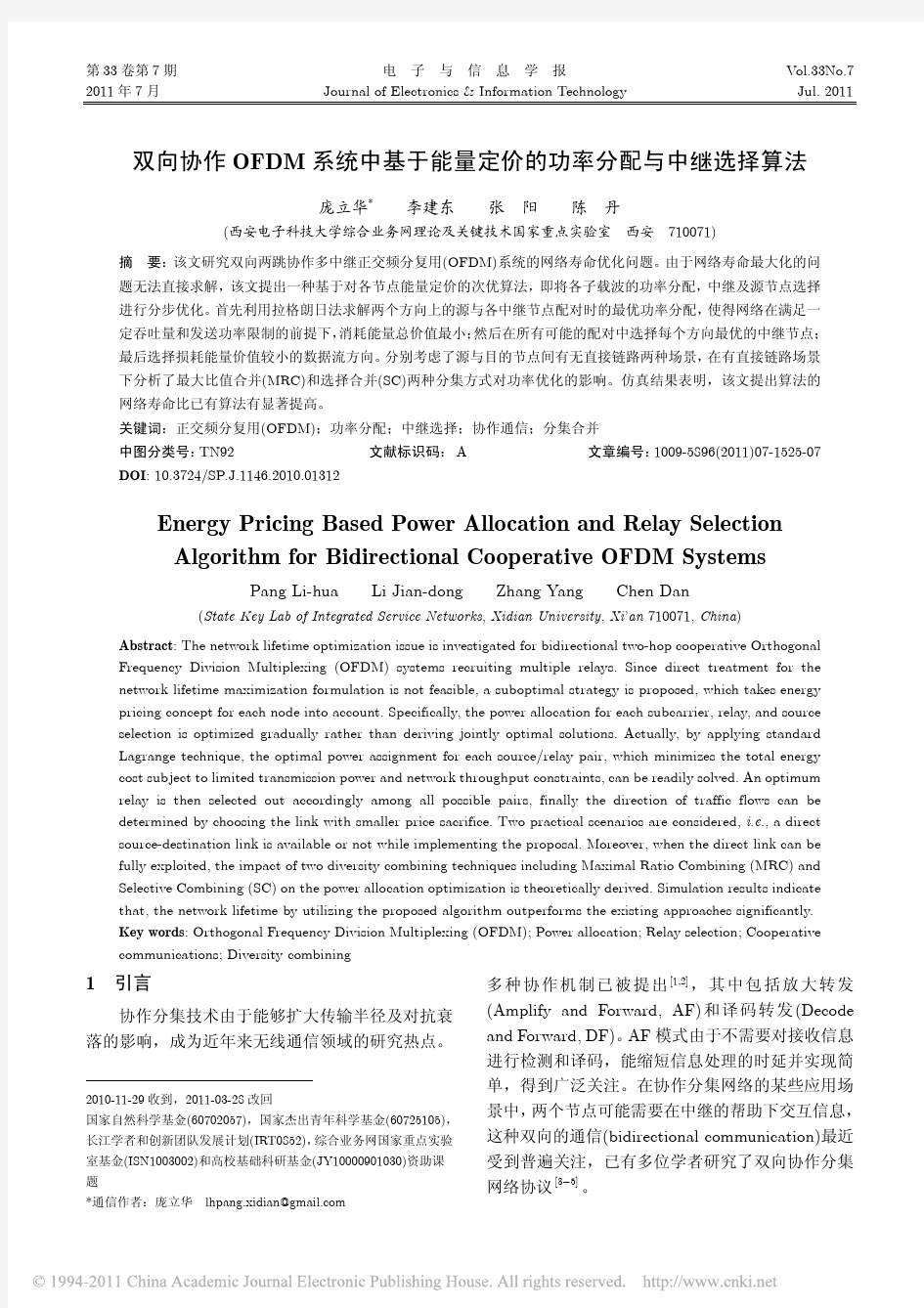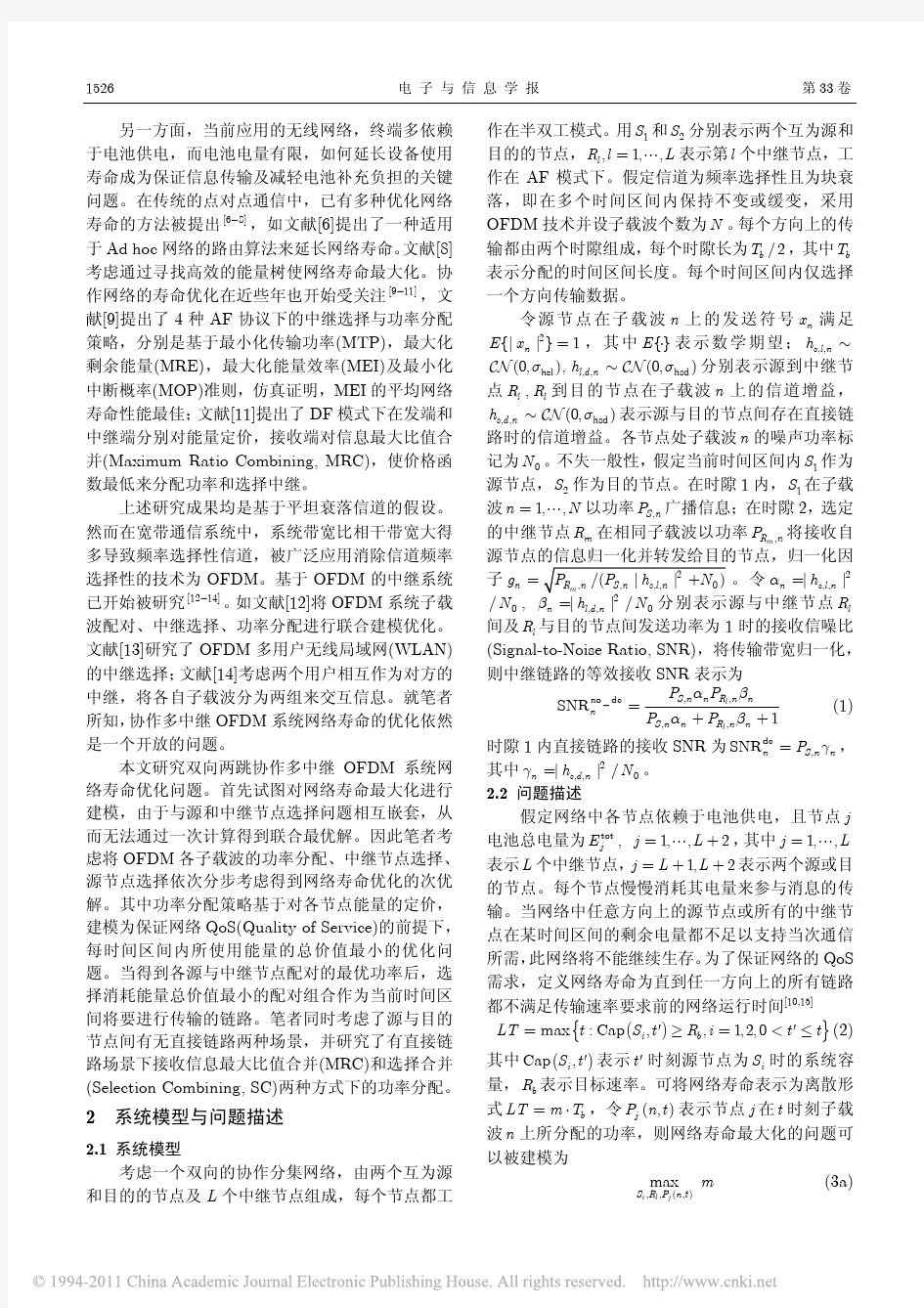双向协作OFDM系统中基于能量定价的功率分配与中继选择算法(2011)


OFDM同步算法
A Novel Timing Estimation Method for OFDM Systems Byungjoon Park,Student Member,IEEE,Hyunsoo Cheon,Student Member,IEEE, Changeon Kang,Senior Member,IEEE,and Daesik Hong,Member,IEEE Abstract—In this letter,we present a novel timing offset estima-tion method for orthogonal frequency division multiplexing sys-tems.The estimator proposed here is designed to avoid the ambi-guity which occurs in Schmidl’s timing offset estimation method. The performance of the proposed scheme is presented in terms of mean and mean-square error(MSE)obtained by simulations.The simulation results show that the proposed estimator has a signifi-cantly smaller MSE than the other estimators. Index Terms—Orthogonal frequency division multiplexing (OFDM),preamble,timing offset estimation. I.I NTRODUCTION S YNCHRONIZATION has been a major research topic in orthogonal frequency division multiplexing(OFDM)sys-tems due to the sensitivity to symbol timing and carrier fre-quency offset[1].Several approaches have been proposed to estimate time and frequency offset either jointly or individually [2]–[4]. The most popular of the pilot-aided algorithms is the method proposed by Schmidl[5].His method uses a preamble con-taining the same two halves to estimate the symbol timing and frequency offset.Schmidl’s estimator provides simple and ro-bust estimates for symbol timing and carrier frequency offset. However,the timing metric of Schmidl’s method has a plateau, which causes a large variance in the timing estimate. To reduce the uncertainty arising from the timing metric, Minn proposed a method as a modification to Schmidl’s approach[6].Minn’s preamble yields a sharper timing metric and smaller variance than Schmidl’s.While Minn’s estimator provides accurate estimation,the variance of estimation is quite large in ISI channels. This letter contains our proposal for a new timing synchro-nization method for OFDM timing estimation which produces an even sharper timing metric than Schmidl’s and Minn’s. In Section II we introduce the OFDM signal model and de-scribe the existing timing estimation methods.Section III covers the proposed preamble and timing offset estimation method.In Section IV,the performances of the proposed estimator and the other estimators are compared in terms of mean-square error Manuscript received November6,2002.The associate editor coordinating the review of this paper and approving it for publication was Prof.P.Loubaton. This work was supported by the Basic Research Program of the Korea Science and Engineering Foundation under Grant R01-2000-000-00271-0(2002)and by LG Electronics. The authors are with the Information and Telecommunication Laboratory, Department of Electrical and Electronic Engineering,Yonsei University,Seoul, Korea(e-mail:mgballs@itl.yonsei.kr). Digital Object Identifier10.1109/LCOMM.2003.812181using computer simulation results.Finally conclusion is drawn in Section V. II.S YSTEM D ESCRIPTION A.OFDM Signal Description Consider a general case of a OFDM system,using the stan-dard complex-valued baseband equivalent signal model. The is the channel impulse response,whose memory is denoted by (2) where yield the received signal (3) where is the initial phase. B.OFDM Timing Synchronization The goal of OFDM timing synchronization is to estimate where (4) 1089-7798/03$17.00?2003IEEE
第二路由器无线中继设置方法
第二路由器无线中继设置方法 以腾达路由器设置为例,下面所说的路由器都是第二台即中继路由器。 假设此路由器的IP是192.168.0.1,与第一台路由器的相同。 一、先由一台电脑与路由器相连,并已知当前路由器的IP地址,然后设置本电脑的IP地址与路由器是一个网段(设置操作:桌面右键点“网上邻居”→属性→右键点“本地连接”→属性→Internet 协议TPC/IP): 进入路由器设置后,进入“高级设置”,步骤如下: 一、“LAN口设置”,修改路由器LAN口地址,注意本路由器和上级(主)路由器的IP的第三段不能相同,比如,主路由器的IP地址为192.168.0.1,那么中继路由器的IP可为192.168.1.X或192.168.2.X都可以。 本案中,上级路由器IP是192.168.0.1,本路由器的IP设置为192.168.1.1 这时,本电脑就不能访问此路由器了,需要修改IP地址,将原来的IP改成如下参数: 再次进入路由器。
二、“W AN口介质类型”,选中“无线W AN”,然后点“开启扫描”,这时本路由器会找到很多的上级路由器的列表。
1.选中你要连接的上级路由器→确定,这时“无线信号名称”栏会自动填入上级路由器名称,2.然后你再用手工输入上级路由器的无线登录密码即可(此处的无线信号名称和密码都是范例)。 在输入密码的下面,点“关闭扫描”→在最下面点“确定”。至此,调试本路由器的台式机就可以上网了。
三、“DHCP服务器”,将,DHCP服务器勾选“启用”→确定,至此,第二台中继路由器设置完毕。注意,如果不设置此项,手机找到此路由器后,就会停留在“正在分配IP地址”处就不动了。 设置完成后,此台路由器就可以放在离第一台路由器较远、但还能收到信号的地方,实际上这台路由器是“不存在”了,它的SSID和密码都是第一台路由器的,它只起到了一个中继信号的放大作用。手机或笔记本收到的WIFI看起来就好像是第一台路由器的。 注意,如果第一台路由器的SSID和密码一旦修改,或者更换了路由器,那么中继路由器就必须重新安装上面的步骤重新设置。
基于云计算环境的蚁群优化计算资源分配算法
基于云计算环境的蚁群优化计算资源分配算法 华夏渝,郑骏,胡文心 (华东师范大学计算中心,上海200241) 摘要:针对云计算的性质,提出一种基于蚁群优化(Ant Colony Optimization )的计算资源分配算法。分配计算资源时,首先预测潜在可用节点的计算质量,然后根据云计算环境的特点,通过分析诸如带宽占用、线路质量、响应时间等因素对分配的影响,利用蚁群优化得到一组最优的计算资源。通过在Gridsim环境下的仿真分析和比较,这种算法能够在满足云计算环境要求的前提下,获得比其他一些针对网格的分配算法更短的响应时间和更好地运行质量,因而更加适合于云环境。 关键词:云计算;网格;蚁群;资源分配 中图分类号:TP316 文献标识码:A Ant Colony Optimization Algorithm for Computing Resource Allocation Based On Cloud Computing Environment Hua xia-yu, Zheng jun, Hu wen-xin (Computer Center Institute, East China Normal University Shanghai, 200241) Abstract:A new allocation algorithm based on Ant Colony Optimization (ACO) was established to satisfy the property of Cloud Computing. When start, this algorithm first prognosticated the capability of the potential available resource node, and then analyzed some factors such as network qualities or response times to acquire a set of optimal compute resources. This algorithm met the needs of cloud computing more than others for Grid environment with shorter response time and better performance, which were proved by the simulation results in the Gridsim environment. Key words: Cloud Computing; Grid; Ant Colony Optimization; resource allocation 0引言 云计算(Cloud Computing),是指通过互联网连接的超级计算模式,包含了分布式处理(Distributed Computing)、并行处理(Parallel Computing)和网格计算(Grid Computing)的相关技术,或者说是这些计算机科学概念的商业实现。 云计算一种新型的共享基础架构,可以将巨大的系统池连接在一起,以运营商和客户的方式,通过互联网为用户提供各种存储和计算资源。在云计算环境中,用户将自己的个人电脑,PDA或移动电话等其他设备上的大量信息和处理器资源集中在一起,协同工作。这是一个大规模的分布式计算模式,该模式由运营商的经济规模决定,并且是抽象的,虚拟化的以及规模动态可变的。其主要内容为受管理的计算能力,存储,平台和服务。这些内容通过互联网,按需分配给外部用户,其重要意义在于将计算能力作为一种商品在互联网上进行流通。 云计算的主要优势:快速地降低硬件成本和提升计算能力以及存储容量,用户可以以极低的成本投入获得极高的计算能力,而不用再投资购买昂贵的硬件设备,负担频繁的保养与升级 计算资源分配是云计算技术的一个重要组成部分,其效率直接影响整个云计算环境的工作性能。由于云计算有很多独特的特性,使得原有的针对网格计算的资源分配和调度算法已无法在该环境中有效的工作。本文提出的蚁群优化分配算法,综合考虑了云计算的一系列特点,以期在这种环境中能够高效地为用户作业分配合适的计算资源。 1 问题描述 云计算由网格计算演变而成,并将网格计算作为其骨干和基本结构。可以说,云计算是网格计算的一种更高级的形式。但是,这两者之间在现实中存在着巨大的区别,具体可以参见文献[1]。 云计算提供了更多抽象的资源和服务。这些资源和服务可划分为三个类别,分别是软件即服务(Software as a Service),平台即服务(Platform as a Service)和设备即服务(Infrastructure as a Service) [2,3]。 在软件即服务(SaaS)中,用户会得到一个特殊用途的客户端,该客户端允许用户通过互联网进行远程访问,并且基于使用情况来收取费用。
ofdm算法
OFDM的原理及优缺点 摘要正交频分复用OFDM(OrthogonalFrequencyDivisionMultiplex)是一种多载波调制方式,通过减小和消除码间串扰的影响来克服信道的频率选择性衰落。它的基本原理是将信号分割为N个子信号,然后用N个子信号分别调制N个相互正交的子载波。由于子载波的频谱相互重叠,因而可以得到较高的频谱效率。关键词OFDM; 频分复用;码间串扰 1 前言 无干扰传输的窄带系统与CDMA相比: 优点:用户性能对其他用户的接收功率不敏感 1.不用对功率进行准确控制(同一小区中的用户传输相互正交) 2.不需要对执行严格的功率控制的固定开销。 缺点:存在由频率复用率带来的损失。 由于不进行干扰平均,实际上并不适合于全局频率复用宽带系统OFDM可以将上述两类系统的良好特性结合在一起。 在小区内保持传输的正交性,并且在小区之间进行全局频率复用,还可以进行干扰平均。 2 基本原理或思想 正交频分复用,英文原称Orthogonal Frequency Division Multiplexing,缩写为OFDM,实际上是MCM Multi-CarrierModulation多载波调制的一种。其主要思想是:将信道分成若干正交子信道,将高速数据信号转换成并行的低速子数据流,调制到在每个子信道上进行传输。正交信号可以通过在接收端采用相关技术来分开,这样可以减少子信道之间的相互干扰 ICI 。每个子信道上的信号带宽小于信道的相关带宽,因此每个子信道上的可以看成平坦性衰落,从而可以消除符号间干扰。而且由于每个子信道的带宽仅仅是原信道带宽的一小部分,信道均衡变得相对容易。 OFDM是一种高效的数据传输方式,其基本思想是在频域内将给定信道分成许多正交子信道,在每个子信道上使用一个子载波进行调制,并且各子载波并行传输。这样,尽管总的信道是非平坦的,具有频率选择性,但是每个子信道是相对平坦的(频带窄),在每个子信道上进行的是窄带传输,信号带宽小于信道的相应带宽,因此就可以大大消除信号波形间的干扰。OFDM相对于一般的多载波传输的不同之处是它允许子载波频谱部分重叠,只要满足子载波间相互正交,则可以从混叠的子子载波上分离出数据信号。由于OFDM允许子载波频谱混跌,其频谱效率大大提高,因而是一种高效的调制方式。
NETGEAR无线路由器无线中继功能介绍
NETGEAR无线路由器无线中继功能介绍 环境 某小型办公室,开通电信ADSL宽带,使用一台NETGEAR无线路由器共享上网。位于角落的会议室,信号较弱。怎样才能有效提高无线网络的覆盖效果呢? 解决方案 确认原有型号支持无线中继(WDS)功能,新购一台NETGEAR无线路由器,与已有的无线路由进行无线中继。 【注意】如果办公室原有的无线路由器属于其他品牌。务必首先确认,已有的无线路由是否具备无线中继功能。只有都具备WDS的功能,两个无线设备才能实现中继。 另外,目前WDS还非国际标准,跨品牌产品之间的无线中继,不能保证一定成功。 NETGEAR无线产品线中,所有无线AP都支持WDS功能。部分无线路由器也逐步扩展了这项功能,具体型号见下表。(WGR614v9/KWGR614需升级至最新固件版本) Wireless-N 900系列Wireless-N 750系列Wireless-N 600系列WNDR4500 WNDR4000 WNDRMAC WNDR3800 WNDR3700 WNDR3400 DGND3700 Wireless-N 300系列Wireless-N 150系列Wireless-G 54系列WNR3500L WNR3500 WNR612 WGR612 JNR3210 JNR3000 WGR614v10 WGR614v9 WNR2200 WNR2000 WNR500 KWGR614 JWNR2000T JWNR2000 WNDR3300 本文配置方法适用于上述各个型号。 网络拓扑 A连接宽带,B在远端与A中继。
【注意】NETGEAR路由器的MAC地址,可以在设备背面查看条形码,也可以在管理界面的“路由器状态下”查看,“局域网端口”下的MAC地址,即为中继所用的MAC. 无线中继设置 1. 登录A的管理界面19 2.168.1.1,点击左侧菜单中的安装->无线设置。若路由器默认无线频道为 auto(自动),必须首先将频道改为固定的数值,推荐使用1、6或11。 【注意】无线网络标识默认NETGEAR,也可以用数字字母任意命名,进行中继的两个路由器,SSID可以相同,也可以不同。如果希望无线客户端在两个无线路由器的范围内实现漫游,请将
存储管理动态异长存储资源分配算法
. 存储管理—动态异长存储资源分配算法 一、设计目的 理解动态异长存储分区资源管理,掌握所需数据结构和管理程序,了解各种 存储分配算法的优点和缺点。 二、设计内容 (1)分析UNIX最先适应(First Fit,FF)存储分配算法,即map数据结构、存储分配函数malloc()和存储释放函数mfree(),找出与算法有关的成分。 (2) 修改上述与算法有关的成分,使其分别体现BF(Best Fit,最佳适应) 分配原则和WF(Worst Fit,最环适应)分配原则。 三、设计准备(理论、技术) 1.最先适应(First Fit,FF)算法 指对于存储申请命令,选取满足申请长度要求且起始地址最小的空闲区域。在实现时,可以将系统中所有的空闲区域按照起始地址由小到大的次序依次记录于空闲区域表中。当进程申请存储空间时,系统由表的头部开始查找,取满足要求的第一个表目。如果表目所对应的区域长度恰好与申请的区域长度相同,则将该区域全部分配给申请者,否则将该区域分割为两部分,一部分的长度与申请长度相同,将其分配给申请者;另一部分的长度为原长度与分配长度之差,将其记录在空闲区域表中 2.最佳适应(Best Fit,BF)算法 是为了克服最先适应算法缺点提出的。它在分配时取满足申请要求且长度最小的空间区域。在实现时,可以将系统中所有的空闲区域按照长度由小到大的次序依次记录于空闲区域表中。当进程申请存储空间时,系统由表的头部开始查找,取满足要求的第一个表目。 3.最坏适应(Worst Fit,WF)算法 是为了克服最佳适应算法的缺点而提出的。它在分配时取满足申请要求且长度最大的空闲区域。在实现时,可以将系统中所有的空闲区域按照长度由小到大的次序依次记录于空闲区域表中。当进程申请存储空间时,取第一个表目。 4.程序设计技术分析 按题目题目首先对存储分配表进行初始化;然后对用户输入的请求和释放,按照动态更新存储分配表,并将每次更新之后的存储分配表在屏幕上显示出来 动态分区分配需要解决三个问题:A.对于请求表中的要求内存长度,从可用表或自由链寻找出合适的空闲区域分配程序。B.分配空闲区后更新自由链或可用表。 C.进程或作业释放内存资源时,合并相邻空闲区并刷新可用表。 四、设计过程(设计思想、代码实现)
无线AP无线网桥无线中继配置详细说明
5G网桥使用说明 一、连线方式如下: 1、使用独立电源时: 2、使用POE交换机时:
二、工作场景: 1、无线AP场景(Bridge-AP桥AP模式) 此场景为最常用模式,AP不为下级终端分配IP,即DHCP由上级路由器完成,只作为 无线网络的发射器,设备地址不是网关地址,需单独设置,默认地址为192.168.62.1,首次使用请用网线连接并将电脑IP设置如192.168.62.12,即和AP接口地址在同一 个网段上,这样才能访问到设备,输入默认密码admin即可进入设备配置页面。 本模式适合无线覆盖、网桥等需求。 此模式当上级路由器或网络不通时将连接不上WiFi信号,原因是设备无法为终端配 置IP地址。 2、无线中继场景(Bridge-Repeater桥中继模式) 此场景为无线AP场景的网络延伸,此时设备接收其它AP发射出的无线信号放大后 再发射出去,以达到不需要布线将网络中继的目的,它只是AP网络的一个延伸, 不为。 此模式当上级路由器或网络不通时将连接不上WiFi信号,原因是设备无法为终端配 置IP地址。 3、无线终端(Bridge-Station 桥终端模式) 此场景将AP作为一个无线终端,它将其它AP发射出的信号接收后转换成有线网络,相当于一个无线网卡,不为终端分配IP地址,IP地址由上级路由器分配。 此模式当上级路由器或网络不通时将连接不上WiFi信号,原因是设备无法为终端配 置IP地址。 4、无线路由场景(Router-AP 路由AP模式) 此场景为最常用模式,AP作为无线路由器使用,对下级终端分配IP地址,设备地 址即为网关地址,默认地址为192.168.62.1,在连接到它的终端上使用网关地址即 可管理设备,输入默认密码admin即可进入设备配置页面。 本模式适合无线覆盖等需求、和家用路由器功能一样。 5、无线路由中继场景(Router-Repeater路由中继模式) 此场景为无线AP网络延伸,此时设备接收其它AP发射出的无线信号放大后再发射 出去,以达到不需要布线将网络中继的目的,同时为连接它的终端分配IP地址。 6、无线路由终端场景(Router-Station 路由终端模式) 此场景将AP作为一个无线终端,它将其它AP发射出的信号接收后转换成有线网络,相当于一个无线网卡、并为终端分配IP地址。 三、配置案例: 1、作为网桥 网桥分为中心站和远端站,使用基础配置向导可简单完成。步骤如下: 中心站配置: (1)、设备按连线示意图接通上电,将LAN口连接到外网的网络插到电脑 (2)、修改本机IP为192.168.62.12 (3)、浏览器打开192.168.62.1,进入配置登录页面,输入默认密码admin
基于节点剩余功率的多中继选择算法_覃琴
基于节点剩余功率的多中继选择算法 覃 琴1,2,曾志民2,张天魁2,张从青2 (1. 三峡大学计算机与信息学院,湖北 宜昌 443002;2. 北京邮电大学信息与通信工程学院,北京 100876) 摘 要:提出一种基于节点剩余功率的多中继放大转发协同节点选择算法,根据节点信道状态信息(CSI)和剩余能量信息对网络生存时间进行优化,使用加权函数和信道容量增益门限进行多协同节点选择。仿真结果表明,对于动态和固定功率分配,该算法选择三四个中继可使协同通信系统性能达到最优;相对基于CSI 的单中继选择算法,当中继数为4时,其在动态功率分配时的网络生存时间最高可延长82%。关键词:协作分集;剩余功率;放大转发;多中继选择;网络生存时间 Multi-relay Selection Algorithm Based on Node Residual Power QIN Qin 1,2, ZENG Zhi-min 2, ZHANG Tian-kui 2, ZHANG Cong-qing 2 (1. College of Computer & Information Technology, China Three Gorges University, Yichang 443002, China; 2. School of Information and Communication Engineering, Beijing University of Posts and Telecommunications, Beijing 100876, China) 【Abstract 】This paper presents a multi-relay Amplification Forwarding(AF) cooperative node selection algorithm based on Residual Power(RP), which jointly considers the Channel State Information(CSI) and the residual energy information of nodes to optimize the network lifetime, uses the weighting function and the channel capacity gain threshold to select the relay set. Simulation results show that both dynamic relay power distribution and fixed relay power distribution, performance reached the best while selecting the 3~4 relays. Relative to only considering the CSI node selection algorithm, this algorithm is able to extend network lifetime up to 82% under dynamic relay power distribution and 4 relay numbers. 【Key words 】cooperative diversity; Residual Power(RP); Amplification Forwarding(AF); multi-relay selection; network lifetime DOI: 10.3969/j.issn.1000-3428.2011.10.025 计 算 机 工 程 Computer Engineering 第37卷 第10期 V ol.37 No.10 2011年5月 May 2011 ·网络与通信· 文章编号:1000—3428(2011)10—0076—03文献标识码:A 中图分类号:TP301.6 1 概述 协同中继使特定区域内的用户可以共享彼此的天线,形 成虚拟天线阵列,从而达到空间分集的效果,显著提高用户服务质量和系统吞吐量[1]。但由于中继节点的加入,用户可以选择不同的中继集合进行数据的转发。因此,在多协同中继环境中,如何进行中继节点选择是首先需要解决的问题。 协作转发主要有放大转发(Amplification Forwarding, AF)、译码转发(Decode Forwarding, DF)和编码协作(Coding Cooperation, CC)3种方式。文献[2]提出机会中继(Opportunistic Relaying, OR)选择方法,分别讨论译码转发和放大转发中协同通信的性能,主要是基于信道状态信息(Channel State Information, CSI)和网络拓扑进行中继选择。 文献[3]分析了在网络总发射功率约束下的中继选择,但多数是单中继选择。 基于单中继的最佳中继选择能够提高系统性能,但无法获得多个中继节点协同通信带来的增益最大化。部分文献讨论了通过穷举搜索法得到中继集合,选取集合中全部中继节点参与信息的转发,其缺点是当中继数增多时,会产生严重的资源分散问题。 协作分集用于Ad Hoc 网络时,采用分布式且低功耗的中继选择算法,使网络生存时间最大化成为设计的关键[4]。文献[5]提出了PARS 的分布式中继选择协议,其中,准则2和准则3考虑了节点剩余功率确定最佳中继,但仍局限为单中继选择。本文将单中继选择推广到多中继选择,综合考虑节点的CSI 和剩余功率,选择可以最大限度延长网络生存时间的中继集合,从而提高网络节点生存时间。 2 协同通信系统模型和问题描述 协同通信系统模型如图1所示。系统有一个源节点S , 一个目的节点D ,N 个中继节点。假设每个中继仅有一个天线,S 和D 之间无直连链路。 图1 协同通信系统模型 假设第i 个中继节点仅知道自身2跳信道系数h is 、h id ,目的节点知道全部中继2跳信道系数。所有信道系数是独立同分布的归一化瑞利随机变量。采用2个阶段AF 中继协议: (1)源节点S 以功率P S 广播发射,发射范围内所有节点收到携带噪声的信号,中继i 接收功率为h si P S 。 基金项目:国家自然科学基金资助项目“基于时域频谱利用概率分布曲线拟合的频谱检测研究”(60772110) 作者简介:覃 琴(1970-),女,副教授、硕士,主研方向:宽带无线通信网络;曾志民,教授、博士、博士生导师;张天魁,讲师、博士;张从青,硕士研究生 收稿日期:2010-11-25 E-mail :q_qin2000@https://www.sodocs.net/doc/5c13884119.html,
基于LTE的D2D资源分配最优算法
Resource Sharing Optimization for Device-to-Device Communication Underlaying Cellular Networks Chia-Hao Yu,Klaus Doppler,C′a ssio B.Ribeiro,and Olav Tirkkonen Abstract—We consider Device-to-Device(D2D)communication underlaying cellular networks to improve local services.The system aims to optimize the throughput over the shared resources while ful?lling prioritized cellular service constraints.Optimum resource allocation and power control between the cellular and D2D connections that share the same resources are analyzed for different resource sharing modes.Optimality is discussed under practical constraints such as minimum and maximum spectral ef?ciency restrictions,and maximum transmit power or energy limitation.It is found that in most of the considered cases,optimum power control and resource allocation for the considered resource sharing modes can either be solved in closed form or searched from a?nite set.The performance of the D2D underlay system is evaluated in both a single-cell scenario,and a Manhattan grid environment with multiple WINNER II A1of?ce buildings.The results show that by proper resource management, D2D communication can effectively improve the total throughput without generating harmful interference to cellular networks. Index Terms—Cellular networks,device-to-device,D2D,peer-to-peer,resource sharing,underlay. I.I NTRODUCTION T HE increasing demand for higher data rates for local area services and gradually increased spectrum conges-tion have triggered research activities for improved spectral ef?ciency and interference management.Cognitive radio sys-tems[1]have gained much attention because of their poten-tial for reusing the assigned spectrum among other reasons. Conceptually,cognitive radio systems locally utilize“white spaces”in the spectrum for,e.g.,ad hoc networks[2][3] for local services.Major efforts have been spent as well on the development of next-generation wireless communication systems such as3GPP Long Term Evolution(LTE)1and WiMAX2.Currently,the further evolution of such systems is speci?ed under the scope of IMT-Advanced.One of the main concerns of these developments is to largely improve the services in the local area scenarios.Device-to-Device (D2D)communication as an underlaying network to cel-lular networks[4][5]can share the cellular resources for Manuscript received November26,2010;revised February11,2011and March23,2011;accepted April20,2011.The associate editor coordinating the review of this paper and approving it for publication was N.Kato. C.-H.Yu and O.Tirkkonen are with the Department of Communi-cations and Networking,Aalto University,Finland(e-mail:{chiahao.yu, olav.tirkkonen}@aalto.?). K.Doppler and C.B.Ribeiro are with Nokia Research Center,Nokia Group (e-mail:{klaus.doppler,cassio.ribeiro}@https://www.sodocs.net/doc/5c13884119.html,). Digital Object Identi?er10.1109/TWC.2011.060811.102120 1see https://www.sodocs.net/doc/5c13884119.html,/ 2see https://www.sodocs.net/doc/5c13884119.html,/better spectral utilization.In addition to cellular operations where the network services are provided to User Equipment (UE)through the Base Stations(BSs),UE may communicate directly with each other over D2D links while remaining control under the BSs.Due to its potential of improving local services,D2D communication has received much attention recently[6][7][8][9][10][11][12][13][14][15][16]. The idea of enabling D2D connections in cellular networks for handling local traf?c can be found in,e.g.,[17][18][19], where ad hoc D2D connections are used for relaying pur-poses.However,with these methods the spectral utilization of licensed bands cannot be improved as D2D connections take place in license-exempt bands.Furthermore,ad hoc D2D connections may be unstable as interference coordination is usually not possible.In[20],non-orthogonal resource shar-ing between the coexisting cellular and ad hoc networks is considered.As the operations of both types of networks are independent(with independent traf?c loads),interference coordination between them considers only the density of transmitters.Recent works on D2D communication assume the same air interface as the underlaying cellular networks. In[21],the cellular resources are reused by D2D connections in an orthogonal manner,i.e.,D2D connections use reserved resources.Although orthogonal resource sharing eases the task of interference management,better resource utilization may be achieved by non-orthogonal resource sharing.In[4][5],a non-orthogonal resource sharing scheme is assumed.Cellular users can engage in D2D operation when it is bene?cial for the users or system.Further,D2D power control when reusing Uplink(UL)cellular resources,where cellular signaling for UL power control can be utilized,is addressed to constrain the interference impact to cellular operations. To better improve the gain from intra-cell spatial reuse of the same resources,multi-user diversity gain can be achieved by properly pairing the cellular and D2D users for sharing the resources[8][9][10].In[10],the resource allocation scheme over multiple cellular users and D2D users considers the local interference situations,making it possible for inter-cell interference avoidance.Interference randomization through resource hopping is considered in[11].This provides more homogeneous services among users in challenging interfer-ence environments,e.g.,when one cellular connection shares resources with multiple D2D pairs at the same time.Integra-tion of D2D communication into an LTE-Advanced network is investigated in[13][14],where schemes for D2D session setup 1536-1276/11$25.00c?2011IEEE
